Environmental Health & Safety (EH&S) is committed to working with University personnel to reduce the risk of accidents and injuries before, during, and after procedures involving sharps. The following resources will help you and your staff avoid needlesticks and sharps injuries.
Before the procedure
We recommend preparing to work with sharps by doing the following:
- Eliminate sharps from procedures or substitute for safer sharps devices as appropriate.
- Develop written procedures for safe handling and disposing of sharps.
- Train all personnel working with sharps.
- Prepare for exposure and spill response.
The best way to avoid needlestick and other sharps injuries is to avoid using a sharps device when it is not necessary. The next best way is to use tools to minimize the hazard, such as a safety-engineered device or a needle-syringe holder.
First, identify all sharps devices used in your procedures, then consider the following:
Eliminate sharps
Consider ways to perform the task without a sharps device. Can the same function be performed without a needle or sharp?
Examples:
- Eliminate glass by choosing plastic when possible.
- Use a pipet or similar device to homogenize or mix a solution (rather than using a needle for this purpose)
Additional suggestions for eliminating sharps are provided in the Recommendations sections below.
Substitute sharps
It is estimated that 62-88% of injuries can be avoided through the use of safer devices. Consider selecting a safer device that will accomplish the same result while also lowering your risk of injury.
Examples:
- Use sharp tissue scissors to cut tissue rather than a razor blade for more control.
- Use a plastic gel cutter instead of a razor blade to cut electrophoresis gels.
- Use a blunt needle in place of a sharply pointed one.
- Safety-engineered devices for needles, syringes, scalpels, blood-draw vacutainer devices, and more can be used in place of the same items without a safety feature. For example, the BD vacutainer blood collection device shown below.
- Luer-lock syringes are highly recommended, to securely screw the needle onto the syringe (vs standard ‘slip tip’ that allows a needle to push onto the end of a syringe).
Additional suggestions for substituting sharps are provided in the Recommendations sections below.
Environmental Health & Safety can recommend safer sharps devices that align with your procedures and desired result.
Prior to beginning a new procedure, develop a standard operating procedure (SOP) that describes:
- Steps to perform the procedure safely
- Tools and instruments that are needed to perform the procedure safely
- Personal protective equipment
- Steps for responding to an accident, exposure or injury
- Safe disposal of needles and other sharps
Resources for developing an SOP include:
- Download an SOP template.
- Refer to the Recommendations sections below.
- Review the Sharps Safety Tools and Resources Presentation or Poster.
- Contact us for recommendations on eliminating sharps and selecting safer devices.
Notes
- If working with human blood or other potentially infectious materials, you must also follow the UW Bloodborne Pathogens Program requirements and have a site-specific exposure control plan. Safer sharps procedures can be incorporated into your Site-Specific Exposure Control Plan.
- A Biological Use Authorization may be needed for use of human source materials in research.
Consult with your supervisor to determine the required and recommended training you must complete prior to beginning work. This includes practicing with less hazardous materials to develop proficiency.
Training may include:
During the procedure
During all procedures involving sharps, awareness of your surroundings and careful action is required to avoid accidents and injuries. Best practice is to announce that sharps are in use when others are present. Always wear the appropriate personal protective equipment (PPE) and follow all written procedures.
In addition, keep in mind the following safe work practices.
- Avoid recapping needles. Use a needle holder to recap a syringe only if necessary, for example when giving dental anesthetic with multiple injections.
- Dispose of uncapped needles immediately after use. Never leave an uncapped needle laying loose on a work surface.
- Use a tool such as a forceps to remove a needle from a syringe, if removal is necessary.
- Point the needle away from yourself and others.
- Keep visual contact with the needle at all times while uncapped.
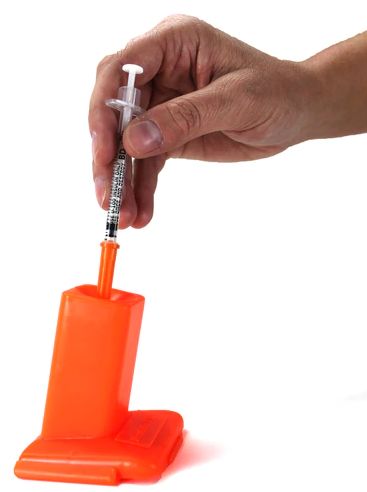
EH&S recommends using an OSHA-compliant one-handed needle recapper, such as:
- NeedleSafe II® or NeRd® needle recapper
- Delasco Recapper and Syringe Holder (pictured)
Video: Using a NeedleSafe II needle uncapper/recapper and syringe holder
- Use disposable safety scalpels with a fixed blade and a retractable sheath when possible.
- Don’t use excessive force or a sawing motion when using a scalpel.
- Don’t use your fingers to hold a razor blade. Use blade with a handle, or use pliers to place the razor blade in a holder.
- Don’t cut or trim an object you are holding with your other hand. Use forceps or another tool to hold an object while cutting.
- Sharp tissue scissors provide more control than a razor blade for cutting tissue.
- Purchase safety cutters to open boxes.
- Don’t use a razor blade to cut smaller strips of tape from a larger roll. Order the appropriate sized tape.
- Don’t get distracted and rush though the task.
- Place reusable sharps in a reusable sharps container immediately after use.
Video: How to safely attach a scalpel blade to a handle
After the procedure
Keep an appropriately sized sharps container near your work area and immediately dispose of sharps after the procedure.
- Needles should never be laid uncapped on a workbench.
- Sharps that retract after use should be disposed of like all other sharps.
- Use caution when working near others, so that one person’s sharps do not enter the field where another person is working.
Refer to the Sharps and Lab Glass Waste page for more information about treating and disposing of sharps.
Never fill a sharps container more than two-thirds full.
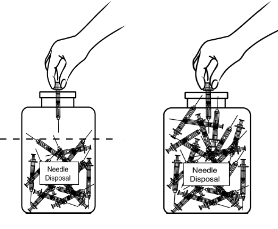
Image source: Princeton University
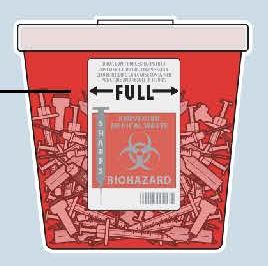
Overfilling a sharps container presents hazards to those using it, and to those collecting the containers for disposal.
Image source: Outagamie and Winnebago counties
EH&S recommends using one-handed blade remover such as the Disposable Blade Remover or BladeFlask Blade Remover.
Refer to the Work Safely with Sharps Focus Sheet for more information.
Recommendations for in vitro procedures
The following recommendations for eliminating and substituting sharps, and practices for safer handling of sharps devices can be incorporated into your in vitro SOPs.
For procedures such as cleaning wells of acrylamide gels, pipetting, transferring reagents or filling certain cassettes, using something other than a needle may be possible. Fine tip micropipette tips or transfer pipets may achieve the same results.
Here are some examples of fine tip pipet options:
Although glass Pasteur pipettes are commonly used for cell culture and other precision pipetting activities, there are safer plastic alternatives available. Here are some examples:
Instead of using a razor blade to cut electrophoresis gels or excise bands from gels, try a plastic cutter or excision tip. Plastic gel cutters or plastic safety razors can also be used to chop or mince soft tissues. Here are some examples:
Avoid exposure to glass edges that can result in cuts and contamination while using ampules.
EH&S recommends Qlicksmart® SnapIT Ampoule Opener and inplusDESIGN Ampoule Opener.
Video: Using the Qlicksmart SnapIT Ampoule Opener
For injecting samples to analyze, transferring reagents, and similar procedures, using a blunt end needle is a safe alternative to a hypodermic-type needle. A variety of blunt end needles are available in many different sizes. Here are some examples:
EH&S recommends using blunt scissors or disposable safety cutters with a recessed or concealed blade, such as a Klever Cutter (pictured).
Pick up sharps safety. EH&S recommends using Soldering Straight Gripper or Hemostat Forceps.
Use needlestick, cut, puncture, and abrasion-resistant gloves. EH&S recommends PointGuard® Ultra 6044 or HexArmo® SharpsMaster® II 9014.
Sometimes a needle is essential to the procedure. In this case, use a sharps holder device for reusable needles. If you use needles to inject into analyzers, consider storing them in a sharps holder device. Here are some examples:
Recommendations for in vivo procedures
The following recommendations for eliminating and substituting sharps, and practices for safer handling of sharps devices can be incorporated into your in vivo SOP.
Use a gentle restraint while avoiding injury to personnel and animals.
EH&S recommends ScruffGuard or LabArt Restraint.
Video: Use of a ScruffGuard.
EH&S recommends substituting a syringe used for blood draw with one of the following safety-engineered devices:
- 3mL VanishPoint Syringe 20-25G x 1" or 5/8"
- 1mL VanishPoint Tuberculin Syringe 25G x 5/8”
- EasyPoint needle 23G x 1” (25mm)
- EasyPoint needle 25G x 1” (25mm)
- EasyPoint needle 25G x 5/8” (16mm)
EH&S recommends substituting a USO insulin syringe used for subcutaneous injection with one of the following safety-engineered devices:
- 1mL VanishPoint Tuberculin Syringe 27G x 1/2”
- 1mL VanishPoint U-100 Insulin Syringe 29G x 1/2”
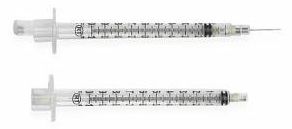
1mL VanishPoint Tuberculin syringe (pictured)
EH&S recommends substituting a needle with syringe or needle with vacutainer used for sedation with ketamine with a 3mL VanishPoint syringe (typically 23g).
EH&S recommends substituting a needle with syringe or needle with vacutainer used for blood draw with BD Vacutainer Eclipse.
EH&S recommends substituting a butterfly needle used for venous blood draw or IV injection with VanishPoint Blood Collection Set (Retractable) 23G x ¾”(Available with or without luer adapter and in 7'' or 12'' tubing).
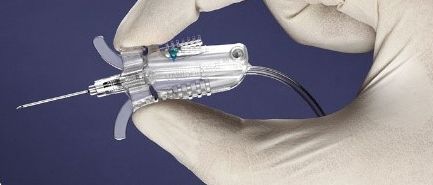
VanishPoint blood collection set holder (pictured)
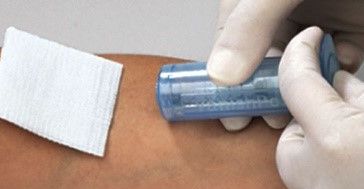
VanishPoint blood collection tube (pictured)
EH&S recommends substituting a needle with syringe used for subcutaneous injection with 1mL VanishPoint Tuberculin Syringe 27G x 1/2” or 1mL VanishPoint U-100 Insulin Syringe 29G x 1/2”.

1mL VanishPoint Tuberculin syringe (pictured)
EH&S recommends substituting a needle with syringe used for blood draw with 3mL VanishPoint Syringe 20G x 1” or 3mL VanishPoint Syringe 20G x 1½”.
EH&S recommends substituting a needle with injection cap, butterfly catheter, tubing, and syringe used for IM injection with the following safety-engineered devices:
- VanishPoint Blood Collection Set (Retractable) 21G x ¾” (19mm) 7”
- VanishPoint Blood Collection Set 23G x ¾” (19mm) 7”
- 3mL VanishPoint Syringe 20G x 1”
- 3mL VanishPoint Syringe 21G x 1”
- 3mL VanishPoint Syringe 22G x 1”
(Blood Collection Sets available in 12" tubing)

VanishPoint blood collection set (pictured)

VanishPoint blood collection tube holder (pictured)
EH&S recommends substituting an IV catheter needle used for venous or arterial blood draw with Radiopaque PUR 22G 1” (Available in FEP or PUR).
Exposure and spill response
Be prepared for a sharps injury or exposure by placing the Exposure Response Poster in a visible location.
- Call 9-1-1 for a life-threatening injury or emergency.
- Follow the instructions on the Exposure Response Poster.
- Report the incident to your supervisor and to Environmental Health & Safety as soon as possible.
When filling out the OARS report, note the type of sharp involved, as well as any substances, chemicals, or agents you may have been exposed to.
Spill cleanup
Refer to the Spill Response poster for spill response and cleanup information.
Refer to the Biohazardous Spills guidance for spills involving biohazards.
More information
Environmental Health & Safety is available for consultation on procedures that involve needles and other sharps devices, including;
- Developing written procedures
- Recommending safer sharps devices
- Providing training and demonstrations
- Identifying and referring subject matter experts to consult on specific procedures
Refer to the Work Safely with Sharps Focus Sheet for a quick reference guide to safer work practices.
For questions about sharps use and disposal in laboratories, contact EH&S Biosafety.
For questions about sharps use in healthcare settings, contact the UW Employee Health Center.
Visit the Sharps and Lab Glass Waste page for more information about disposing of sharps waste.
Sharps are devices, such as needles, scalpels, and lancets, which are used to cut or pierce skin, blood vessels or tissue.
Sharps injuries are among the most commonly reported injuries in UW research and clinical settings. Precautions to prevent injury and exposure to biological, chemical, and other potentially hazardous agents are essential when working with sharp items.
Frequently asked questions
Visit the Sharps and Lab Glass Waste page for information on disposing of sharps waste.
Environmental Health & Safety is available for consultation on procedures that involve needles and other sharps devices.
For questions about sharps use in laboratories, contact EH&S Biosafety.
For questions about sharps use in healthcare settings, contact the UW Employee Health Center.
